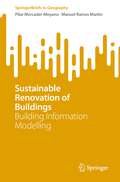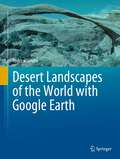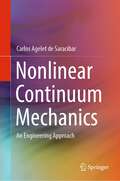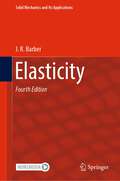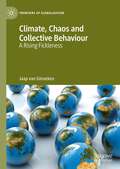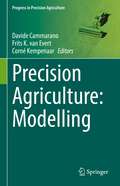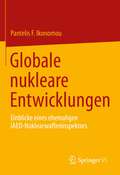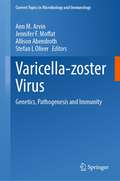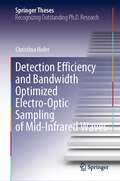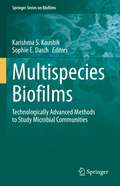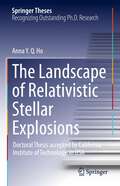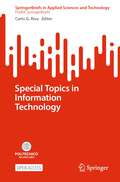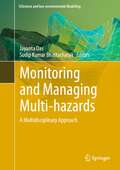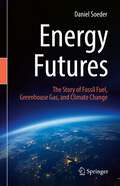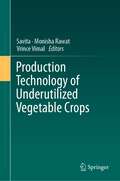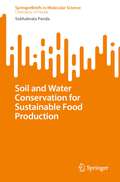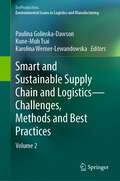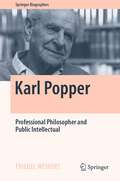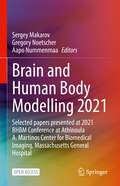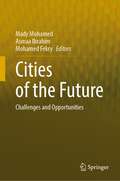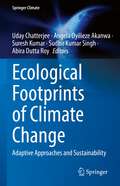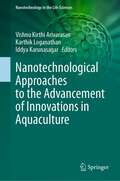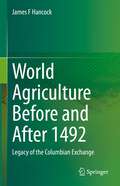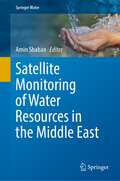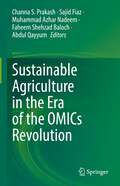- Table View
- List View
Sustainable Renovation of Buildings: Building Information Modelling (SpringerBriefs in Geography)
by Pilar Mercader-Moyano Manuel Ramos MartínThe book provides a complete vision about Spanish sustainable renovation of buildings situation at this moment, analysing legal and technological context and opportunities that economic stimulus —by means of direct aids— and the use of BIM methodologies offers a standardization of high scale interventions.Nowadays, BIM models let us integrate multiple quantitative parameters that can agile the information to interchange between stakeholders. Using this potential to standardize protocols of interventions and share knowledge is necessary to face a high scale intervention that our cities need.Climatic Emergency and socioeconomic crisis caused by recent events —COVID-19 and hydrocarbons crisis— are the two principal struggles we face as society. European Politics, embodied by National Energy and Climate Plans (NECPs) developed by each region give the way to the green transition of different productive sectors.Our building stock is responsible for approximately 36% of the CO2 emissions in the European Union. For this reason, these policies focus a large part of their efforts on economically incentivizing a new development model for the building sector that is committed to the large-scale renovation of the existing real estate stock and that, through the reduction of energy demand and of emissions, manage to reduce the environmental impact of these. Next Generation EU is the new recovery instrument that aims to mobilize investments towards strategic sectors for the reorientation of the production model that, among other measures, contributes to decarbonization through the promotion of energy efficiency and the deployment of renewable energies.
Desert Landscapes of the World with Google Earth
by Andrew GoudieThis book presents an introduction to desert landscapes—primarily landforms that are natural and man-made. It is based around the presentation of a series of beautiful and informative annotated Google Earth images. These are accompanied by text that describes the feature(s) concerned, their location, and their origin. There are also, in some cases, ground images taken by the author.
Nonlinear Continuum Mechanics: An Engineering Approach
by Carlos Agelet de SaracibarThis textbook on Continuum Mechanics presents 9 chapters. Chapters 1 and 2 are devoted to Tensor Algebra and Tensor Analysis. Part I of the book includes the next 3 chapters. All the content here is valid for both solid and fluid materials. At the end of Part I, the reader should be able to set up in local spatial/material form, the fundamental governing equations and inequalities for a Continuum Mechanics problem. Part II of the book, Chapters 6 to 10, is devoted to presenting some nonlinear constitutive models for Nonlinear Solid Mechanics, including Finite Deformation Hyperelasticity, Finite Deformation Plasticity, Finite Deformation Coupled Thermoplasticity, and Finite Deformation Contact Mechanics. The constitutive equations are derived within a thermodynamically consistent framework. Finite deformation elastoplasticity models are based on a multiplicative decomposition of the deformation gradient and the notion of an intermediate configuration. Different formulations based on the intermediate configuration, the current or spatial configuration, and the material configuration are considered. The last chapter is devoted to Variational Methods in Solid Mechanics, a fundamental topic in Computational Mechanics. The book may be used as a textbook for an advanced Master’s course on Nonlinear Continuum Mechanics for graduate students in Civil, Mechanical or Aerospace Engineering, Applied Mathematics, or Applied Physics, with an interest in Continuum Mechanics and Computational Mechanics.
Elasticity (Solid Mechanics and Its Applications #172)
by J. R. BarberThis book emphasizes engineering applications of elasticity. This is a first-year graduate textbook in linear elasticity. It is written with the practical engineering reader in mind, dependence on previous knowledge of solid mechanics, continuum mechanics or mathematics being minimized. Examples are generally worked through to final expressions for the stress and displacement fields in order to explore the engineering consequences of the results. This 4th edition presents new and revised material, notably on the Eshelby inclusion problem and anisotropic elasticity.The topics covered are chosen with a view to modern research applications in fracture mechanics, composite materials, tribology and numerical methods. Thus, significant attention is given to crack and contact problems, problems involving interfaces between dissimilar media, thermoelasticity, singular asymptotic stress fields and three-dimensional problems.
Climate, Chaos and Collective Behaviour: A Rising Fickleness (Frontiers of Globalization)
by Jaap van GinnekenThis book introduces principles of Chaos theory (and Complex Adaptive Systems) to social science, in a lively and elegant way. It applies it to the twin disciplines of mass psychology (under social psychology, mostly in Europe) and collective behavior sociology (mostly in North America) that deal with emergent psychosocial phenomena that lie outside conventional approaches. Each of the eleven chapters begins with a topical ‘case study’ section, on an issue related to climate change and collective behaviour, such as the ‘school strike’ by Swedish schoolgirl Greta Thunberg, the Hollywood movie The Day After Tomorrow, and more. This book aims to show that there are fundamental reasons why many phenomena cannot be easily ‘measured, predicted and controlled’, and thus we need to familiarize ourselves with alternative ways of thinking about them.
Precision Agriculture: Modelling (Progress in Precision Agriculture)
by Davide Cammarano Frits K. van Evert Corné KempenaarThis book describes how models are used to monitor crops and soils in precision agriculture, and how they are used to support farmers’ decisions. The introductory section starts with an overview of precision agriculture from the early days of yield monitoring in the 1980s to the present, with a focus on the role of models. The section continues with descriptions of the different kinds of models and the opportunities for their application in precision agriculture. The section concludes with a chapter on socio-economic drivers and obstacles to the adoption of precision agriculture technologies. The middle section of the book explores the state-of-the-art in modeling for precision agriculture. Individual chapters focus on the major processes in precision agriculture: water use, nitrogen and other amendments, as well as weeds, pests and diseases. The final section contains a series of short chapters that each describe a commercial, model-based service that is currently available to farmers. The book aims to provide useful information to graduate-level professionals that want to broaden their knowledge of precision agriculture; to scientists who want to learn about using academic knowledge in practical farming; and to farmers, farm consultants and extension workers who want to increase their understanding of the science behind some of the commercial software available to the farming community.
Globale nukleare Entwicklungen: Einblicke eines ehemaligen IAEO- Nuklearwaffeninspektors
by Pantelis F. IkonomouDieses Buch wurde von einem ehemaligen Nuklearinspektor der Internationalen Atomenergiebehörde (IAEO) und Experten für nukleare Sicherheit geschrieben und bietet einen umfassenden und authentischen Überblick über die aktuellen globalen Entwicklungen im Nuklearbereich. Der Autor gibt detaillierte Einblicke in aktuelle und vergangene Nuklearkrisen und legt die technischen Fähigkeiten, politischen Strategien und Motive der Besitzer von Atomwaffen offen. Durch die Analyse der Nuklearprogramme und -strategien verschiedener Länder, darunter die USA, Russland, China, Großbritannien und Frankreich, verdeutlicht dieses Buch die bestehende globale nukleare Bedrohung und die damit verbundenen Risiken für die Menschheit. Es beschreibt auch die derzeitigen Blockaden und zeigt mögliche Auswege auf. Aufgrund seines Umfangs wird das Buch Wissenschaftler und politische Entscheidungsträger ansprechen, die daran interessiert sind, neue Einblicke in sensible oder komplexe Nuklearprogramme verschiedener Länder zu gewinnen.
Varicella-zoster Virus: Genetics, Pathogenesis and Immunity (Current Topics in Microbiology and Immunology #438)
by Ann M. Arvin Jennifer F. Moffat Allison Abendroth Stefan L OliverThis edited volume provides insights about the molecular virology, pathoenesis of infection and host responses to varicella-zoster virus, which is a medically important human herpesvirus. The chapters not only discuss genetics and molecular evolution of the virus, but also new structure-based knowledge on the functions of viral glycoproteins. Further, the authors illustrate how mechanisms from the virus are used to take over and remodel host cells during pathogeneis. These mechanisms also enable viral modulation of host cells and evasion of the host immune response. Part of these evasion and survival strategies, is the reaction to triggered host cell responses like autophagy, the stress response, modulation of apoptosis and other cell death pathways. This hands-on knowledge is crucial for students and clinicians in Virology, Immunology, and Infectious Diseases.Chapter "Common features between stroke following varicella in children and stroke following herpes zoster in adults" is available open access under a Creative Commons Attribution 4.0 International License via Springerlink.com.
Detection Efficiency and Bandwidth Optimized Electro-Optic Sampling of Mid-Infrared Waves (Springer Theses)
by Christina HoferThis thesis investigates the detection efficiency of field-resolved measurements of ultrashort mid-infrared waves via electro-optic sampling for the first time. Employing high-power gate pulses and phase-matched upconversion in thick nonlinear crystals, unprecedented efficiencies are achieved for octave-spanning fields in this wavelength range. In combination with state-of-the art, high-power, ultrashort mid-infrared sources, this allows to demonstrate a new regime of linear detection dynamic range for field strengths from mV/cm to MV/cm-levels. These results crucially contribute to the development of field-resolved spectrometers for early disease detection, as fundamental vibrational modes of (bio-)molecules lie in the investigated spectral range.The results are discussed and compared with previous sensitivity records for electric-field measurements and reference is made to related implementations of the described characterization technique. Including a detailed theoretical description and simulation results, the work elucidates crucial scaling laws, characteristics and limitations. The thesis will thus serve as an educational introduction to the topic of field-resolved measurements using electro-optic sampling, giving detailed instructions on simulations and experimental implementations. At the same time, it showcases the state-of-the-art in terms of detection sensitivity for characterizing mid-infrared waves.
Multispecies Biofilms: Technologically Advanced Methods to Study Microbial Communities (Springer Series on Biofilms #12)
by Karishma S. Kaushik Sophie E. DarchIn an age of antibiotic resistant infections, the study of biofilms is increasingly important. Microbes more than often exist in complex multi-species or polymicrobial communities, making infections difficult to detect, diagnose and treat. Given the increased focus on studying biofilms in research and laboratory settings, particularly under conditions that closely mimic the clinical state, it is important to get an overview of the recent methods, model systems and tools being developed and employed in this context.This book offers readers the opportunity to learn more about current methods being used in the investigation of multi-species biofilms, both in vivo and in vitro. For this, the book highlights new technologies built and designed for the study of multiple species within biofilm communities, including those that can be leveraged for the evaluation of antimicrobial treatment approaches. The application of these state-of-the-art techniques to further our understanding of multi-species biofilms will be discussed and the reader will learn how the clinical microenvironment and the development of biofilm communities are considered when developing such tools.With cutting-edge contributions from experts in the respective domains, this book will benefit translational and basic research scientists, as well as clinicians, and is an informative resource for educators and their students.
The Landscape of Relativistic Stellar Explosions (Springer Theses)
by Anna Y. HoThis thesis reports the discovery of relativistic stellar explosions outside of the gamma ray band, using optical time domain surveys. It is well known that some massive stars end their lives with the formation of a compact object (a neutron star or black hole) that launches a relativistic jet detectable from earth as a burst of gamma rays. It has long been suspected, however, that gamma ray bursts are only the tip of the iceberg in a broad landscape of relativistic explosions, and so the results presented in this thesis represent a major breakthrough. Highlights of this thesis include: characterization of the first major new class of relativistic explosions in a decade; the discovery of abrupt end-of-life mass-loss in a surprisingly diverse range of stars; and the routine discovery of afterglow emission and several events that may represent baryonically dirty jets or jets viewed slightly off axis. These discoveries necessitated the solution of difficult technical challenges such as the identification of rare and fleeting “needles” in a vast haystack of time-varying phenomena in the night sky, and responding to discoveries within hours to obtain data across the electromagnetic spectrum from X-rays to radio wavelengths.
Special Topics in Information Technology (SpringerBriefs in Applied Sciences and Technology)
by Carlo G. RivaThis open access book presents outstanding doctoral dissertations in Information Technology from the Department of Electronics, Information and Bioengineering, Politecnico di Milano, Italy. Information Technology has always been highly interdisciplinary, as many aspects have to be considered in IT systems. The doctoral studies program in IT at Politecnico di Milano emphasizes this interdisciplinary nature, which is becoming more and more important in recent technological advances, in collaborative projects, and in the education of young researchers.Accordingly, the focus of advanced research is on pursuing a rigorous approach to specific research topics starting from a broad background in various areas of Information Technology, especially Computer Science and Engineering, Electronics, Systems and Control, and Telecommunications.Each year, more than 50 PhDs graduate from the program. This book gathers the outcomes of the best theses defended in 2021-22 and selected for the IT PhD Award. Each of the authors provides a chapter summarizing his/her findings, including an introduction, description of methods, main achievements and future work on the topic. Hence, the book provides a cutting-edge overview of the latest research trends in Information Technology at Politecnico di Milano, presented in an easy-to-read format that will also appeal to non-specialists.
Monitoring and Managing Multi-hazards: A Multidisciplinary Approach (GIScience and Geo-environmental Modelling)
by Jayanta Das Sudip Kumar BhattacharyaTo monitor multi-hazards, Remote Sensing and GIS-based multi-criteria decision-making (MCDM) techniques have been extensively used in recent years worldwide. Since natural hazards cannot be eliminated, only quantification of these events and reliable forecasting can alleviate their detrimental effects, through which we can build more resilient and safe societies. Moreover, cultivating the proper knowledge of the multi-hazards and their monitoring and management can fill the gap between science, policy, and the community concerned. In an endeavor to understand and characterize the various hazards, Monitoring and Managing Multi-hazards: A Multidisciplinary approach presents a synthesis of what cross-disciplinary researchers know about these hazards and indigenous adaptation strategies.The book therefore focuses on the use of precision techniques, Remote Sensing, and GIS technologies to quantify various natural, environmental and social hazards along with the capacity building and sustainable mitigation strategies towards resilient societies. It encompasses both thematic and regional case studies to highlight the dynamicity of climate change, change of natural resources, landscape, water, river, agricultural, and social ecosystems at various spatio-temporal scales, including theoretical and applied aspects. The book gives readers an overview and analysis of traditional and advanced geospatial technologies on atmospheric, lithospheric, hydrosphere, biospheric and socio-economic contexts, on all spatial and temporal scales regarding hazards and disasters and sustainable development and management for the future.
Energy Futures: The Story of Fossil Fuel, Greenhouse Gas, and Climate Change
by Daniel SoederThe objective of this book is to help readers better understand the links between fossil fuel, greenhouse gas, and climate change in a clear, explanatory format. It avoids sensationalism and politics, using plain language to explain the details of the science, how the science works, and how we know what we know. It describes the history of fossil fuels, why fossil fuel combustion products are a problem, and what must be done to address the impacts on climate. It provides details about a number of energy engineering solutions to replace fossil fuels and technology called geoengineering that can cool the planet and directly remove greenhouse gases from the atmosphere. Some of these technologies can be implemented almost immediately, and others may be applied in the future. Many young people are pessimistic about the future and prepared to give up on addressing climate change. The book strives to maintain hope throughout that humanity can solve this and other environmental problems. The climate crisis was caused by human engineering, and human engineering can fix it. The goal is to produce informed readers that can have responsible discussions with their political leaders about implementing solutions to climate change.
Production Technology of Underutilized Vegetable Crops
by Savita Monisha Rawat Vrince VimalThis volume discusses the nutraceutical importance, production technologies, management and cultivation practices of underutilized vegetables, which can be described as those vegetable crops which are neither grown commercially on a large scale nor traded widely. While much of the crops addressed in the book are cultivated, traded and consumed at the local level, there are over 60 species of minor vegetables with high growth and yield potentials that are not cultivated to a large extent for greater populations. This work highlights the production technologies needed to grow these vegetables on a larger scale and under various adverse soil and climatic conditions, and their nutritional and medical benefits to assist with food security, health and poverty alleviation in rural areas. Production of underutilized vegetables is low, due to the unavailability of planting material, lack of awareness about the nutritional and medicinal importance among the farmers and inadequate information on the production techniques of these crops. In this context, there is an urgent need to take up a program on genetic resources exploration, management, utilization, and improvement of underutilized vegetable crops to ensure food and nutritional security. Readers will learn about these technologies and practices, while also learning about the unique properties and benefits of these underutilized vegetables. The book will be useful for academicians and researchers focusing on vegetable production and breeding, as well as farmers and sustainability scientists looking for underexplored sources of nutrition to benefit large rural populations.
Soil and Water Conservation for Sustainable Food Production (SpringerBriefs in Molecular Science)
by Subhabrata PandaThis book addresses the impact of soil and water quality on food production, and explores soil and water conservation measures to be applied at farm level for agricultural sustainability. Divided into 8 chapters, the book covers topics such as soil properties responsible for soil loss, the impact of climate change, water and biological factors on soil chemistry, the effect of soil on the quality of water including sustaining aquaculture productivity and environment of wetlands, soil and water qualities necessary for irrigation, management of soil organic carbon, and the importance of soil moisture conservation including agroforestry for food production. Particular attention is given to the management of soil organic carbon in sustainable crop cultivation as well as reducing soil erosion and nutrient loss from soil from cultivated lands. The book concludes with a chapter that integrates soil and water conservation with sustainable food production and food safety.
Smart and Sustainable Supply Chain and Logistics — Challenges, Methods and Best Practices: Volume 2 (EcoProduction)
by Paulina Golinska-Dawson Kune-Muh Tsai Karolina Werner-LewandowskaThe application of artificial intelligence methods and the increasing digitalization of the processes in a supply chain contribute the more seamless flow of materials and information. The disturbances in global supply chain during pandemic put pressure on companies to improve the existing operations. The Sustainable Development Goals put pressure on local and global markets to reduce carbon dioxide emissions and to implement a more resource-efficient business model. Integration of physical and cyber systems is necessary to achieve more environmentally friendly, efficient logistics and supply chain operations. This book presents the contemporary issues of sustainability and integration of physical and information flow in supply chain. In the individual chapters, the authors discuss new qualitative and qualitative theoretic methods, models and present case studies from business practice. This book might be a valuable source of knowledge for the academics, PhD students and practitioners to deepen their knowledge in the field of logistics and SCM.
Karl Popper: Professional Philosopher and Public Intellectual (Springer Biographies)
by Friedel WeinertKarl R. Popper is widely regarded as one of the most influential 20th century philosophers. In this new biography, Weinert provides a comprehensive and accessible account of his life and work, also addressing Popper’s role as a public intellectual. Drawing on a wide range of sources and interviews with former colleagues and collaborators, he recounts not only the wide interest from the scientific community, but also the inspiration that politicians took from Popper’s work. The book surveys the vast and varied intellectual landscape of Popper's philosophical journey during his long career: from the natural and social sciences (physics, evolution, sociology) to political philosophy and the philosophy of mind. It pays significant attention to Popper’s critical method - i.e., the notion that ideas and institutions should be exposed to rigorous tests – the approach that led him to a fervent defence of objectivity, rationality and realism, against all forms of irrationalism, as well as a passionate advocacy of freedom, social justice and liberal democracy, against all forms of authoritarianism. The book brings Popper into focus as a modern Enlightenment philosopher.
Brain and Human Body Modelling 2021: Selected papers presented at 2021 BHBM Conference at Athinoula A. Martinos Center for Biomedical Imaging, Massachusetts General Hospital
by Sergey Makarov Gregory Noetscher Aapo NummenmaaThis open access book describes modern applications of computational human modelling to advance neurology, cancer treatment, and radio-frequency studies including regulatory, safety, and wireless communication fields. Readers working on any application that may expose human subjects to electromagnetic radiation will benefit from this book’s coverage of the latest models and techniques available to assess a given technology’s safety and efficacy in a timely and efficient manner.This is an Open Access book.
Cities of the Future: Challenges and Opportunities
by Mady Mohamed Asmaa Ibrahim Mohamed FekryThis book seeks to address the key challenges and opportunities of "future cities" embracing novel approaches and grounded technologies in pursuing a vision for smart, inclusive cities. The objective of this book is to discuss multiple areas at the local, national, and international levels and how these challenges can hinder the development objectives planned to be achieved by the cities of the future. The chapters featured in this collection were presented at the 6th Memaryat International Conference (MIC 2022), held at the Effat University, Jeddah. MIC’s objective is to build bridges between science, technology, and innovation, seen as the key levers of attaining the SDGs.This book provides the most innovative ideas presented at the conference to address the key manifestation of “future cities" to embrace novel approaches and grounded technologies in the pursue of a vision for smart inclusive cities. It thus represents a platform for diverse contributions from academics and practitioners to present their different perspectives addressed theoretically as well as in practice concerning the challenges and opportunities of future cities. This includes contributions from decision-makers, architects, urban planners, urban designers, entrepreneurs, and educators to stimulate discussion covering the latest on the challenges and opportunities for better future cities in the different domains of architecture, building science and technology, environmental design, mobility & infrastructure, urban design & landscape, housing & real estate developments, urban planning, governance, socio-cultural & economic development, community engagement, tourism and heritage revitalization.
Ecological Footprints of Climate Change: Adaptive Approaches and Sustainability (Springer Climate)
by Uday Chatterjee Angela Oyilieze Akanwa Suresh Kumar Sudhir Kumar Singh Abira Dutta RoyThis book explores global implications of human activities that trigger changes in climate and the appropriate scientific, adaptive, and sustainable approaches as a proven information tool. It reveals that the ecological, social, and economic dynamics of the changing earth encompasses huge uncertainties coupled with its ability to be linked to other forms of global change. From a scientific perspective, multiple efforts are expedient to integrate the many aspects of global changes. Increases in science and technology have afforded nations the ability to plan for the future by investing in adaptive and mitigative measures to monitor present and future changes. Just as the climatic and ecological impacts of climate change are unequally distributed, so is the adaptive capacity to cope with these impacts in different nations. Considering that wealth, infrastructure, and political stability all contribute to a nation's capacity to anticipate and respond to change. So, global South nations who are disadvantaged in these areas are faced with more inequalities and more unique adaptive strategies. There is need for increased aggregate efforts and interaction between scientists, stakeholders, and policy makers to improve both decision-making and global change in science. Scientists and researchers need to work on expanding the range of polices that are proposed, debated, and implemented. This way, novelty, new ideas and methodologies are infused into the society. At this point of multiple climate footprints, there is an immense need to explore all ideas evaluating their possibilities in presenting alternative futures, developing alternative policies, and adaptive options to solve the intractable ecological footprints of climate change.
Nanotechnological Approaches to the Advancement of Innovations in Aquaculture (Nanotechnology in the Life Sciences)
by Vishnu Kirthi Arivarasan Karthik Loganathan Iddya KarunasagarThe main practical breakthrough of this century is nanobiotechnology, an amalgamation of biology and nanotechnology based on the standards and methods of metabolism. The field mainly involves the analysis, synthesis and the links between molecular biology, nutritional science and nanotechnology. In addition, the field involves the links between other life sciences branches, since the improvement of nanotechnology strategies might be directed by considering the structure and the capability of nanoparticles present in the living cells. This book is a comprehensive evaluation of the latest nanobiotechnological developments, with an emphasis on applications, especially in aquaculture. It outlines, in-depth, modern techniques, and includes a variety of important sources that make this the perfect resource for researchers in this captivating world of nanobiotechnology.
World Agriculture Before and After 1492: Legacy of the Columbian Exchange
by James F HancockThe year 2022 is the 50th anniversary of Alfred Crosby’s celebrated book - The Columbian Exchange: Biological and Cultural Consequences of 1492. In the book, Crosby was the first to discuss the impact that the Spanish and Portuguese colonial period had on world agriculture and human culture. How the crops of the world became homogenized, and how an indigenous culture was destroyed by disease after Columbus landed. His landmark study broke new ground in its broad conceptualization of the Atlantic exchange.Building on what Crosby so succinctly and brilliantly presented, the main goal of this new work is to present the depth of information that has emerged since "The Columbian Exchange" and to discuss more fully the development of crops and agriculture before and after the Iberian contact. It follows the journey of crops and livestock in the Old and New Worlds and end’s with their distribution in today’s world.
Satellite Monitoring of Water Resources in the Middle East (Springer Water)
by Amin ShabanThis book presents both updated and new measurements on water resources from selective pilot areas form the Middle East. Demand for water has become very crucial notably in arid and semiarid regions like in the Middle East. The changing climate and the increased population are the most striking challenges on water resources in this region where the largest part of its territory is dry lands and deserts with minimal precipitation and high evaporation rates, and thus, the average per capita of water does not exceed 25 m3/year. This resulted in developing many studies and researches in different Middle East countries to clearly identify and assess the hydrological characteristics of the available water resources and to explore new resources in order to secure balanced water supply/demand. As a first of its type, this book introduces comprehensive knowledge on the successful reports of the use of satellite images in water studies in the Middle East, and the economic value resulted from adopting these techniques. Based on illustrated case-studies the book will represent a significant resource for a large number of experts, academics, researchers, engineers and different-level stakeholders including the decision makers.
Sustainable Agriculture in the Era of the OMICs Revolution
by Channa S. Prakash Sajid Fiaz Muhammad Azhar Nadeem Faheem Shehzad Baloch Abdul QayyumAccess to food with enough calories and nutrients is a fundamental right of every human. The global population has exceeded 7.8 billion and is expected to pass 10 billion by 2055. Such rapid population increase presents a great challenge for food supply. More grain production is needed to provide basic calories for humans. Thus, it is crucial to produce 60-110% more food to fill the gap between food production and the demand of future generations.Meanwhile food nutritional values are of increasing interest to accommodate industrialized modern lives. The instability of food production caused by global climate change presents another great challenge. The global warming rate has become more rapid in recent decades, with more frequent extreme climate change including higher temperatures, drought, and floods. Our world faces various unprecedented scenarios such as rising temperatures, which causes melting glaciers and the resulting various biotic and abiotic stresses, ultimately leading to food scarcity. In these circumstances it is of utmost importance to examine the genetic basis and extensive utilization of germplasm to develop “climate resilient cultivars” through the application of plant breeding and biotechnological tools. Future crops must adapt to these new and unpredictable environments. Crop varieties resistant to biotic and abiotic stresses are also needed as plant disease, insects, drought, high- and low-temperature stresses are expected to be impacted by climate change. Thus, we need a food production system that can simultaneously satisfy societal demands and long-term development.Since the Green Revolution in the 1960s, farming has been heavily dependent on high input of nitrogen and pesticides. This leads to environmental pollution which is not sustainable in the long run. Therefore, a new breeding scheme is urgently needed to enable sustainable agriculture; including new strategies to develop varieties and crops that have high yield potential, high yield stability, and superior grain quality and nutrition while also using less consumption of water, fertilizer, and chemicals in light of environmental protection. While we face these challenges, we also have great opportunities, especially with flourishing developments in omics technologies. High-quality reference genomes are becoming available for a larger number of species, with some species having more than one reference genome. The genome-wide re-sequencing of diverse varieties enables the identification of core- and pan-genomes. An integration of omics data will enable a rapid and high-throughput identification of many genes simultaneously for a relevant trait. This will change our current research paradigm fundamentally from single gene analysis to pathway or network analysis. This will also expand our understanding of crop domestication and improvement. In addition, with the knowledge gained from omics data, in combination with new technologies like targeted gene editing, we can breed new varieties and crops for sustainable agriculture.
